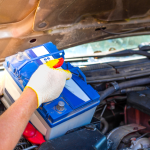In a world defined by divisions and borders, the Trabant emerged as an unexpected symbol of both unity and segregation, capturing the spirit of a bygone era. This iconic vehicle, often referred to as the “plastic wonder,” became a staple on the streets of East Germany, representing the ingenuity of a nation while also embodying the constraints of a rigid regime. As we take a closer look at the Trabant, we delve into its quirky design, cultural significance, and the paradox it represents—a humble car that drove through an intricately woven tapestry of history, from the gray landscapes of the former German Democratic Republic to the vibrant roads of today. Join us as we explore the journey of this classic car from the other side of the wall, and discover how it continues to stir nostalgia and curiosity in the hearts of enthusiasts around the globe.
The Iconic Legacy of the Trabant in Eastern European Automotive History
As the quintessential symbol of East German automotive ingenuity, the Trabant transcended its utilitarian design to become a cultural icon that resonated deeply with the lives of millions throughout Eastern Europe. Produced between 1957 and 1990, the Trabant was more than just a means of transportation; it represented a certain resilience and a way of life under a socialist regime. Its distinctive two-stroke engine, stark bodywork, and minimalist interior have created a nostalgic allure, often celebrated in popular culture and automotive circles alike. Behind its small frame lay the complexities of a society navigating the challenges of limited resources, where car ownership became a powerful emblem of personal freedom and aspiration, especially in the years leading up to the fall of the Berlin Wall.
The revival of the Trabant’s legacy in recent years speaks volumes about its role in shaping Eastern European identity. Today, enthusiasts and collectors seek out these vintage vehicles, not only for their historical significance but also for their quirky charm and simplicity. Classic car shows and events across Europe often feature the Trabant as a nod to the region’s tumultuous past, reminding us of the stories woven into its steel and plastic. As social and economic transformations continue to ripple through Eastern Europe, the Trabant stands as a testament to an era defined by struggle, humor, and an unyielding spirit, ensuring that its place in automotive history remains indelibly etched in the collective memory of the region.
Exploring the Stripped-Down Charm: Features That Define the Trabant Experience
The Trabant, often perceived as a symbol of the Eastern Bloc, embodies a fascinating blend of simplicity and resilience. Its compact design is enhanced by a clean, utilitarian aesthetic that exudes charm. The body, composed of a revolutionary Duroplast material derived from recycled resins, showcases the ingenuity behind its creation, while the minimalist interior features stripped-down components that prioritize functionality over luxury. With little in the way of modern amenities, the Trabant invites drivers to connect with the road in a way that many modern vehicles overlook, evoking a sense of nostalgia for a time when driving was about the experience rather than the technology.
Driving a Trabant is an adventure in itself, characterized by its distinctive two-stroke engine that produces a unique sound akin to a buzzing bee. This small yet mighty powertrain not only signifies the car’s modest performance but also encourages a slower pace of life, allowing drivers to savor the journey rather than rushing to their destination. The simplicity of the Trabant transcends mere transportation; it’s a cultural artifact that reflects a rich history, inviting enthusiasts to explore its quirky charm and appreciate the joys of motoring in a different era, where imperfections became part of its irresistible allure.
Preserving the Past: Restoration Tips for Aspiring Trabant Enthusiasts
When delving into the world of Trabant restoration, it’s crucial to embrace the vehicle’s unique character while honoring its historical significance. Start by establishing a comprehensive plan for your restoration project. Research the specific model you own, understanding its distinct features and common issues. Source original parts or high-quality reproductions, as authenticity plays a key role in value and aesthetic appeal. Join online forums or local clubs dedicated to Trabant enthusiasts; these communities often provide invaluable resources, including part leads and the shared knowledge of seasoned restorers who have navigated similar challenges. Document your progress with photos and detailed notes, which not only preserves the history of your project but may also inspire future restorers.
As you dive into the restoration process, consider the balance between modern upgrades and original design. While it may be tempting to add contemporary conveniences, strive to preserve the traditional essence of the Trabant. Focus on aspects that enhance performance without compromising the car’s iconic look, such as upgraded suspension components or improved electrical systems. When refinishing the body, seek out the original hues or close matches that capture the spirit of the era, as they are pivotal in rekindling nostalgia. don’t rush; every dent, scratch, and wear mark is part of the vehicle’s narrative. Take the time to ensure that each element reflects the love and care that goes into preserving a classic piece of automotive history.
Read More: Budget Friendly Electric Motorcycle To Buy in 2024
Navigating the Collectors Market: What to Consider Before Buying a Trabant
When stepping into the world of Trabant collecting, it’s essential to arm yourself with knowledge about these iconic vehicles, which epitomize a unique era in automotive history. First, consider the provenance of the car. Trabants, produced in East Germany, carry stories from the time of division and have remnants of their past etched into every panel. Investigate the vehicle’s history—was it part of the daily life of an East Berliner or a symbol of rebellion in a period of change? Authenticity is crucial, so look for original parts, factory modifications, and documentation that can enhance the car’s value and narrative.
Beyond the mechanical aspects, understanding the community surrounding Trabants can deepen your investment. Collectors are often passionate about preserving the legacy of these cars, and finding forums or local clubs can provide valuable insights. Engage with other enthusiasts to share advice about maintenance, restoration tips, and market trends, which can be as vital as any engine upgrade. A Trabant isn’t just a car; it’s a bridge to a rich cultural heritage. When you’re ready to make a purchase, remember to assess not just the car’s condition but also the significance it holds in the chronicle of past eras—it’s a valuable part of history you’re considering bringing home.
Concluding Remarks
As we pull the curtain down on our exploration of the Trabant, a symbol of resilience and a unique chapter in automotive history, we hope to have ignited your curiosity about this iconic vehicle that transcended the divide between East and West. More than just a means of transportation, the Trabant represents a cultural artifact, a testament to innovation under constraints, and a beloved memory for many who lived through an era of division.
In the years since the fall of the Berlin Wall, the Trabant has evolved from a utilitarian necessity to a cherished classic, embodying nostalgia for a time that shaped millions of lives. Whether seen coasting through the streets of Berlin or gracing the lawns of classic car shows, this humble little car continues to spark conversations about history, unity, and the passage of time.
As we bid farewell to our journey with the Trabant, we encourage you to look beyond its modest frame and appreciate the stories it carries—of dreams and struggles, of freedom and fallacies. It is a reminder that even the most unassuming vehicles can leave lasting impressions on our collective memory, serving as a bridge between the past and the present. So, next time you see a Trabant, take a moment to reflect on the roads it has traveled and the walls it has helped to dismantle, both on the streets and within the hearts of those who have experienced its journey.











